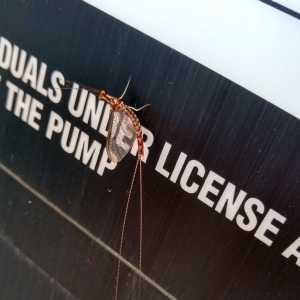Federal Water Tap, July 31: Army Corps Dredges Upper Mississippi as River Levels Drop
The Rundown
- Army Corps dredges river channels as drought again depletes the Mississippi River.
- Senate committee passes budget bills that maintain water infrastructure spending levels.
- Lake Erie harmful algal bloom forecast worsens.
- Army Corps says it needs $3 billion more to complete levee system west of New Orleans and it lowers the risk rating for a recently repaired California dam.
- An EPA draft toxicity review finds that a PFAS compound likely harms immune response in children and the thyroid.
- The EPA’s internal watchdog finds that Chesapeake Bay water pollution reduction will fall short unless more attention is given to nonpoint sources like farms.
- Federal scientists contribute to a study that estimates dam removal costs in the U.S.
And lastly, a federal infrastructure advisory council prepares to vote on a water security report.
“Without EPA assistance to address the remaining nonpoint source pollution, Agency leadership in developing new goals and deadlines, and a process to hold jurisdictions accountable for achieving nonpoint source pollution reductions, the EPA and Chesapeake Bay jurisdictions will not meet TMDL pollutant-reduction goals.” – Excerpt from an EPA Office of the Inspector General report on Chesapeake Bay water pollution targets. The watershed, which covers six states and the District of Columbia, is not on track to meet a 2025 deadline. Pennsylvania, the top polluter, is lagging. The watchdog agency recommended that the EPA develop new approaches to nonpoint pollution (like sediment and farm runoff) and assist states in designing accountability measures. Nonpoint sources are the biggest pollution sources to the bay. The EPA did not agree with these two recommendations, emphasizing its limited authority over nonpoint pollution.
By the Numbers
$152 Million: Funding for six water storage and conveyance projects in three western states. The funds come from the Infrastructure Investment and Jobs Act. The projects include reservoir construction and expansion, and pipelines.
$3 Billion: Additional costs to complete a levee system west of New Orleans. Congress appropriated $760 million for the West Shore Lake Pontchartrain project in 2018. But the Army Corps now says that it needs a lot more money. The funds would pay for increased pumping capacity, repairing damage to swamps during construction, and raising the height of the levees in the future. Inflation and higher labor costs also contributed.
News Briefs
Army Corps Dredges Upper Mississippi River
Less than a year after scarce water halted barge traffic on the lower Mississippi River, dry weather is now depleting the river’s upper reaches.
According to federal river forecasts, three locations (Burlington and Dubuque, Iowa, and Rock Island, Illinois) could be within a foot of their record low within a month, when the river is typically at the lowest.
To maintain navigation channels at a nine-foot depth, the Army Corps of Engineers is operating 11 dredges around the clock in the upper watershed.
Water Spending Preserved in Senate Budget
The Senate Appropriations Committee unanimously approved a 2024 budget for environment agencies that makes no cuts to the state revolving funds, the main federal vehicles for funding water infrastructure.
The drinking water and clean water state revolving funds combined would collect more than $2.7 billion under the Democratic-led proposal.
The Senate budget is in stark contrast to the GOP-led House’s offer, which would cut the revolving funds, providing just $995 million.
The Senate budget differs in other ways. It has fewer water infrastructure earmarks than the House version: $589 million versus $880 million. The earmarks are subtracted from the revolving fund allocations. More earmarks means less money for the loan funds. Municipal water groups worry that this way of budgeting will erode the revolving funds.
Studies and Reports
Lake Erie Algae Bloom Forecast Worsens
Lake Erie’s harmful algal bloom is now expected to measure at least 4.5 on a 10-point severity scale, according to researchers at NOAA and Heidelberg University.
A month ago, the bloom, which is fed by nutrients from farm fields and sewage, was expected to be no worse than a 4.5. The severity scale measures the size of the bloom, not its toxicity.
The annual bloom formed by July 4, the second-earliest start date since 2002. It currently covers about 200 square miles of Lake Erie’s western basin.
Estimating Dam Removal Costs
How much will it cost to unblock a river?
Federal scientists contributed to a study seeking to answer that question.
Using 55 years of data from previous projects, the researchers developed a model to estimate the expense of future dam removals. Key predictors turned out to be dam height, river discharge, and “complexity” such as sediment management.
Public Notification for Lead in Drinking Water
The EPA Office of the Inspector General told the agency that it should take immediate action to ensure that the public is notified when utilities find lead in drinking water above federal action levels.
A rule requiring immediate public notification goes into effect in October 2024, but the Office of the Inspector General says that the agency should take action beforehand.
California Dam Repairs Lower Risk
Following safety improvements, the Army Corps of Engineers lowered the risk rating on Isabella Dam, a move that allows the reservoir in California’s southern Sierra Nevada mountains to be filled to capacity once again.
On the Radar
Glen Canyon Advisory Committee Meeting
The Glen Canyon Dam Adaptive Management Work Group, a federal advisory committee, will hold an in-person and virtual public meeting on August 16-17.
On the agenda: how the Colorado River dams will be operated in 2024, science experiments that could take place next year, and the basin’s endangered and threatened species.
Web conference and dial-in details are found here.
National Infrastructure Advisory Council Meeting
The council that advises the president on infrastructure will meet on August 28 to approve a report on preparing the nation’s critical systems for water crises.
The draft version of the report recommended a cabinet-level Department of Water that would oversee a national water strategy.
The public meeting takes place at 2:30 p.m. Eastern. To register, email NIAC@cisa.dhs.gov.
Clean Water Act Permitting
The EPA proposed a rule that would clarify the steps a state or tribe must take to gain permitting authority under Section 404 of the Clean Water Act. Currently, only three states oversee their permitting program.
PFHxS Human Health Toxicity Review
The EPA’s IRIS program released a draft report on the toxicity to humans of a PFAS compound called PFHxS that is used in carpets, food packaging, textiles, and other consumer goods.
The report notes many limitations with the existing body of scientific work. Nonetheless the report deems, with medium confidence, that PFHxS likely damages the thyroid and hinders immune response in children.
Public comments on the review are being accepted through September 22. Submit them via www.regulations.gov using docket number EPA–HQ–ORD–2021–0562.
Federal Water Tap is a weekly digest spotting trends in U.S. government water policy. To get more water news, follow Circle of Blue on Twitter and sign up for our newsletter.
Brett writes about agriculture, energy, infrastructure, and the politics and economics of water in the United States. He also writes the Federal Water Tap, Circle of Blue’s weekly digest of U.S. government water news. He is the winner of two Society of Environmental Journalists reporting awards, one of the top honors in American environmental journalism: first place for explanatory reporting for a series on septic system pollution in the United States(2016) and third place for beat reporting in a small market (2014). He received the Sierra Club’s Distinguished Service Award in 2018. Brett lives in Seattle, where he hikes the mountains and bakes pies. Contact Brett Walton







Leave a Reply
Want to join the discussion?Feel free to contribute!